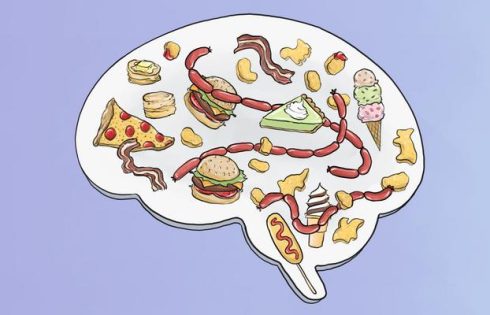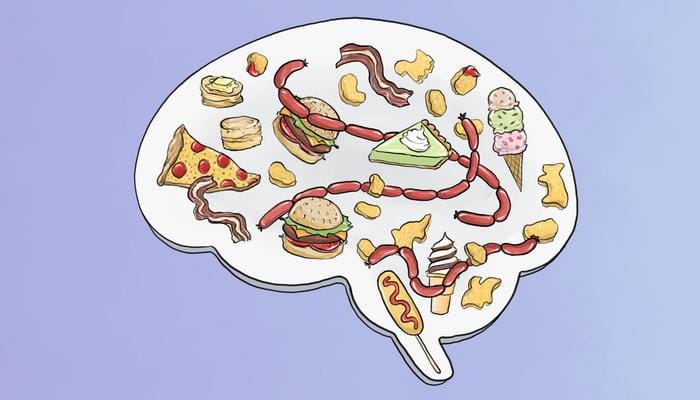
The pleasure we get from eating junk food—the dopamine rush—is often blamed as the cause of overeating and rising obesity rates in our society. But paradoxically, anecdotal evidence suggests that people with obesity may take less pleasure in eating than do individuals with normal weight. Brain scans of obese individuals show reduced activity in pleasure-related brain regions when presented with food, a pattern also observed in animal studies.
Research in mice by scientists at the University of California (UC), Berkeley, has now revealed an unsuspected brain mechanism that may explain why a chronic high-fat diet (HFD) can reduce the desire for high-fat, sugary foods, even when these foods remain easily accessible.
The researchers propose that this lack of desire in individuals with obesity is due to a loss of pleasure in eating caused by long-term consumption of high-calorie foods. Losing this pleasure may actually contribute to the progression of obesity. Their findings indicate that a decline in neurotensin—a brain peptide that interacts with the dopamine network—may represent a possible underlying cause of this phenomenon.
The results suggest that pleasure in eating, even eating calorie-rich high fat, high sugar foods, is key for maintaining a healthy weight in a society that abounds with cheap, high-fat food. The results point to a potential strategy to restore pleasure in eating in a way that helps reduce overall consumption. The researchers found that this effect is driven by a reduction in neurotensin in a specific brain region that connects to the dopamine network. Importantly, they demonstrate that restoring neurotensin levels—either through dietary changes or genetic manipulations that enhance neurotensin production—can reinstate the pleasure in eating and promote weight loss.
“Imagine eating an amazing dessert at a great restaurant in Paris—you experience a burst of dopamine and happiness,” said Neta Gazit Shimoni, PhD, a UC Berkeley postdoctoral fellow. “We found that this same feeling occurs in mice on a normal diet, but is missing in those on a high-fat diet. They may keep eating out of habit or boredom, rather than genuine enjoyment.”
Added research lead Stephan Lammel, PhD, a UC Berkeley professor in the department of neuroscience and a member of the Helen Wills Neuroscience Institute, “A natural inclination toward junk food is not inherently bad—but losing it could further exacerbate obesity. A high-fat diet changes the brain, leading to lower neurotensin levels, which in turn alters how we eat and respond to these foods. We found a way to restore the desire for high-calorie foods, which may actually help with weight management.”
While findings in mice don’t always translate directly to humans, this discovery could open new avenues for addressing obesity by restoring food-related pleasure and breaking unhealthy eating patterns. Lammel, together with co-lead first authors Gazit Shimoni, and former UC Berkeley graduate student Amanda Tose, reported on their findings in Nature, in a paper titled, “Changes in neurotensin signaling drive hedonic devaluation in obesity,” in which they concluded, “Together, our findings identify a neural circuit mechanism that links the devaluation of hedonic foods with obesity.”
“Excessive consumption of high-calorie foods is a key contributor to the development and progression of obesity in humans and animals,” the authors wrote. Doctors and researchers have struggled to understand and treat obesity, as countless fad diets and eating regimens have failed to produce long-term results. The recent success of GLP-1 agonists like Ozempic, which curb appetite by increasing feelings of fullness, stands out among many failed approaches.
Lammel studies brain circuits, particularly the dopamine network, which plays a crucial role in reward and motivation. Dopamine is often associated with pleasure, reinforcing our desire to seek rewarding experiences, such as consuming high-calorie foods.
While raising mice on a high-fat diet, Gazit Shimoni noticed a striking paradox. While they were in their home cages, these mice strongly preferred high-fat chow, which contained 60% fat, over normal chow with only 4% fat, leading them to gain excessive weight. However, when they were taken out of their home cages and given free access to high-calorie treats such as butter, peanut butter, jelly, or chocolate, they showed much less desire to indulge than did normal-diet mice, who immediately ate everything they were offered. The animals on a chronic HFD “… paradoxically exhibited a reduced drive to opportunistically consume high-calorie foods in an acute feeding assay, even when no effort was required to obtain the food,” the team wrote.
Gazit Shimoni further stated, “If you give a normal, regular-diet mouse the chance, they will immediately eat these foods. We only see this paradoxical attenuation of feeding motivation happening in mice on a high-fat diet.” The researchers discovered that this effect had been reported in past studies, but no one had followed up to find out why, and how the effect connects to the obesity phenotype observed in these mice. “This paradoxical decrease in hedonic feeding has been reported previously, but its neurobiological basis remains unclear,” the investigators stated.
To investigate the phenomenon further, Lammel and team used optogenetics, a technique that allows scientists to control brain circuits with light. They found that in normal-diet mice, stimulating a brain circuit that connects to the dopamine network increased their desire to eat high-calorie foods, but in obese mice, the same stimulation had no effect, suggesting that something must have changed. In their paper, the investigators further explained that “… in mice on regular diet, neurons in the lateral nucleus accumbens (NAcLat) projecting to the ventral tegmental area (VTA) encoded hedonic feeding behaviors.” In contrast, they reported, “In HFD mice, this behavior was reduced and uncoupled from neural activity.”
The reason, they discovered, was that neurotensin was reduced so much in obese mice that it prevented dopamine from triggering the usual pleasure response to high-calorie foods. “Neurotensin is this missing link,” Lammel said. “Normally, it enhances dopamine activity to drive reward and motivation. But in high-fat diet mice, neurotensin is downregulated, and they lose the strong desire to consume high-calorie foods—even when easily available.”
The researchers then tested ways to restore neurotensin levels. When obese mice were switched back to a normal diet for two weeks, their neurotensin levels returned to normal, dopamine function was restored, and they regained interest in high-calorie foods.
When neurotensin levels were artificially restored using a genetic approach, the mice not only lost weight, but also showed reduced anxiety and improved mobility. Their feeding behavior also normalized, with increased motivation for high-calorie foods and a simultaneous reduction of their total food consumption in their home cages. “Our results demonstrate that overexpression of NTS mitigates HFD-induced changes in hedonic feeding, anxiety, mobility, and home cage food consumption,” the authors stated.
They suggest that their results demonstrate how “disruptions in NTS signaling contribute to disordered consumption of calorie-rich foods.” Given the role of these foods in driving the obesity epidemic, they suggested, “… targeting NTS signaling in the NAcLat→VTA pathway may offer a promising strategy to regulate food intake and support healthy weight maintenance without disrupting other essential NTS-mediated functions.”
Lammel commented, “Bringing back neurotensin seems to be very, very critical for preventing the loss of desire to consume high-calorie foods. It doesn’t make you immune to getting obese again, but it would help to control eating behavior, to bring it back to normal.”
Although directly administering neurotensin could theoretically restore feeding motivation in obese individuals, neurotensin acts on many brain areas, raising the risk of unwanted side effects. To overcome this, the researchers used gene sequencing, a technique that allowed them to identify specific genes and molecular pathways that regulate neurotensin function in obese mice. This discovery provides crucial molecular targets for future obesity treatments, paving the way for more precise therapies that could selectively enhance neurotensin function without broad systemic effects.
“We now have the full genetic profile of these neurons and how they change with high-fat diets,” Lammel said. “The next step is to explore pathways upstream and downstream of neurotensin to find precise therapeutic targets.”
Lammel and Gazit Shimoni plan to expand their research to explore neurotensin’s role beyond obesity, investigating its involvement in diabetes and eating disorders. “The bigger question is whether these systems interact across different conditions,” Gazit Shimoni said. “How does starvation affect dopamine circuits? What happens in eating disorders? These are the questions we’re looking at next.”

